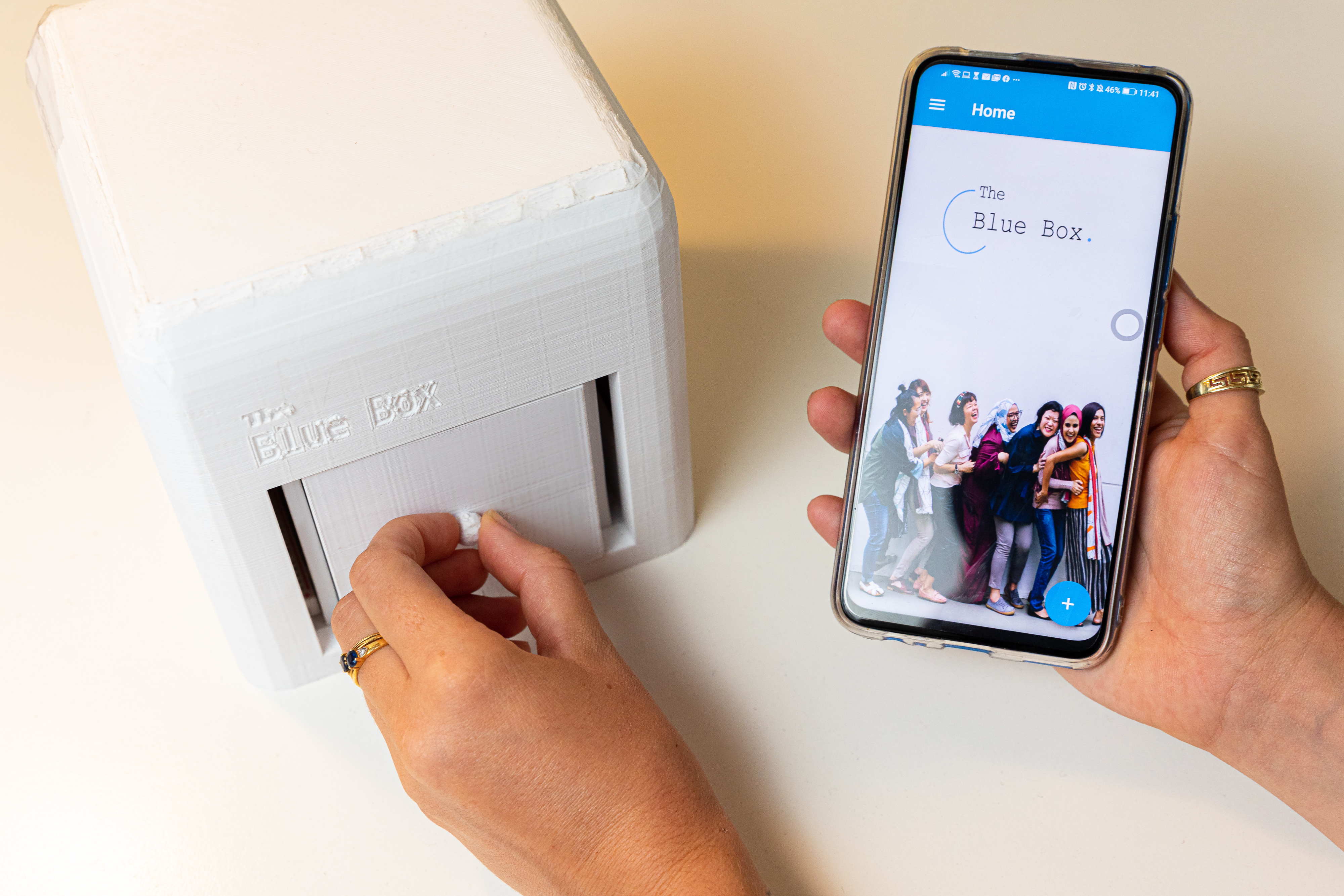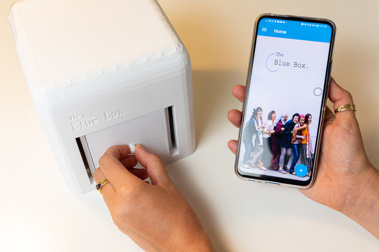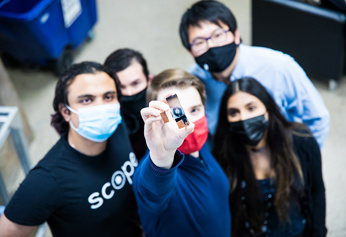2020 marked a record-breaking year for the James Dyson Award, with the highest number of entries ever submitted and largest amount of prize money given to inventors. The Award opened for entries in March against the backdrop of a global crisis. Yet this year’s entrants have shown perseverance and determination to continue their research and development, ensuring pioneering ideas are shared with the world to shape our futures.
This year we announce the international winner and, for the first time ever, the sustainability winner who will both receive £30,000 to help develop their inventions.
International winner – The Blue Box invented by Judit Giró Benet


The problem: 40% of women skip their breast cancer screening mammogram, meaning 1 in 3 are diagnosed too late and face a lower chance of survival.[1] 41% of those who skip mammograms say it is due to pain. As a result, there is a global need for a comfortable and accessible screening process for breast cancer.
The solution: The Blue Box, invented by Judit Giro Benet from Tarragona, Spain, is an at-home, biomedical breast cancer testing device that uses a urine sample and an AI algorithm to detect early signs of breast cancer. It empowers women to take charge of their health with a non-invasive, pain free, non-irradiating and low-cost alternative which can be used regularly at-home. After simply producing a urine sample in the supplied container and inserting it into the Box, the machine performs a chemical analysis of the sample and sends the results to the Cloud. Here, the AI based algorithm reacts to specific metabolites in the urine and currently produces a classification rate of >95% (based on Judit’s research so far), providing the user with a diagnosis. The device is linked to an App which controls all communications to the user, immediately putting them in touch with a medical professional if the sample tests positive.
“I have seen and experienced first-hand the harrowing effects of cancer. So as scientists and engineers, anything we can do to use technology to attempt to overcome this, we should. Judit combines the latest technologies across hardware and software to create a well-designed, holistic product to solve a very real problem that could benefit many people. I was particularly impressed with how well The Blue Box works with sensors and artificial intelligence to maturely function as an electronic device and accompanying app.” James Dyson, Founder and Chief Engineer at Dyson.
On winning the International prize, Judit says, “James Dyson’s support and endorsement strengthens my resolve to develop The Blue Box, striving to potentially save hundreds of thousands of lives. The Blue Box endeavours to change the way society fights breast cancer and to give all women in the world the chance to avoid an advanced diagnosis, making screening a part of our daily lives. So, the day he told me that I had won the International prize was a real turning point for my project. The prize money will allow us to patent more extensively, expediate research and development, and help to ensure our product is viable. But hearing from him, an engineer, that he trusts in my idea has given me the confidence I need at this vital period.”
.
Sustainability winner – AuREUS System Technology invented by Carvey Ehren Maigue

The problem: Fossil fuels continue to account for over 81% of global energy product according to the International Energy Agency. It is estimated that, if we continue to burn fossil fuels at the current rate, global supplies of gas and oil will deplete by 2060. As a result, accessible and effective renewable alternatives need to be prioritised. While renewable energy uptake and solutions continue to grow, many can only generate electricity in the right environmental conditions. For example, Solar panels can only capture and convert visible light into renewable energy and must be facing the sun to do so. What is more, solar farms are only built horizontally too, never vertically and are often placed on prime arable farmland.
The solution: AuREUS System Technology, invented by Carvey Ehren Maigue from Mapua University in Manila, the Philippines,
is a material that can be attached to a pre-existing structure or surface to harvest UV light and convert this into visible light to generate electricity. Using ultraviolet rays, the sun could be shining, or it could be cloudy, Carvey’s material will still generate electricity. The particles in his material absorb UV light causing them to glow. As the particles “rest” they remove excess energy. This excess energy bleeds out of the material as visible light, which can then be transformed into electricity. Current prototypes successfully achieve this on windows and external building structures. Not only has Carvey invented an efficient process to generate renewable energy, but the materials he uses to do so create a closed-loop design process, so nothing is wasted. This is because Carvey uses a substrate extracted from waste crops to create a durable, translucent and mouldable material as the basis for AuREUS.
“As a farmer, I see great potential in Carvey’s technology to generate clean renewable energy. AuREUS System Technology conserves space using pre-existing structures, utilises current resources and waste streams, and supports local agricultural communities. His bright idea to use upcycled crop waste develops a closed loop system. This element of his invention is particularly clever and shows the close link between farming and technology.” James Dyson, Founder and Chief Engineer at Dyson.
Carvey says… “Winning the James Dyson Award is both a beginning and an end. It marked the end of years of doubting whether my idea would find global relevance. It marks the beginning of the journey of finally bringing AuREUS System Technology to the world. I want to create a better form of renewable energy that uses the world’s natural resources, is close to people's lives, forging achievable paths and rallying towards a sustainable and regenerative future.”
.
The James Dyson Award international runners-up
Scope – Ishan Mishra, Holden Beggs, Zhen Le Cao, Fernando J. Pena Cantu, Alisha Bhanji from the University of Waterloo, Canada.

Mobile cameras are unable to achieve high quality zoomed photos, as the lenses cannot use physical movement to zoom without image quality loss, as seen with conventional cameras. Scope has engineered a lens using liquid crystals confined in a cell. When voltages are applied to the crystals it allows for the lens’ optical wave front to be dynamically shaped without physical movement, enabling a lossless camera zoom.
The Tyre Collective – Siobhan Anderson, Hanson Cheng, M Deepak Mallaya, and Hugo Richardson from the Innovation Design Engineering MA/MSc programme at Imperial College London and the Royal College of Art, UK

Every time a vehicle brakes, accelerates or turns a corner, the tyres wear down and tiny particles become airborne, producing half a million tonnes of tyre particles annually in Europe alone. These particles are small enough to become airborne and can have adverse effect on health. The Tyre Collective aims to reduce this invisible pollution by capturing the tyre particles at the source. The team’s device is fitted to the wheel and uses electrostatics to collect particles as they are emitted from the tyres, by taking advantage of various air flows around a spinning wheel. Once captured, the particles can be recycled and reused in new tyres or other materials such as ink.
[1] Centers for Disease Control and Prevention



Partager cette page sur